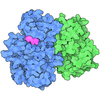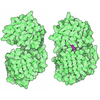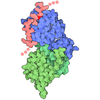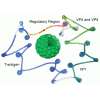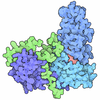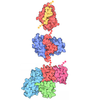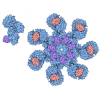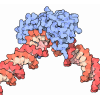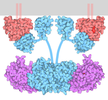+ Open data
Open data
- Basic information
Basic information
| Entry | Database: PDB / ID: 9cb3 | |||||||||
|---|---|---|---|---|---|---|---|---|---|---|
| Title | E2F1-Cyclin F Interface | |||||||||
 Components Components |
| |||||||||
 Keywords Keywords | CELL CYCLE / SCF Ubiquitin Ligase | |||||||||
| Function / homology |  Function and homology information Function and homology informationnegative regulation of centrosome duplication / negative regulation of fat cell proliferation / Rb-E2F complex / re-entry into mitotic cell cycle / lens fiber cell apoptotic process / F-box domain binding / negative regulation of DNA binding / Inhibition of replication initiation of damaged DNA by RB1/E2F1 / PcG protein complex / anaphase-promoting complex binding ...negative regulation of centrosome duplication / negative regulation of fat cell proliferation / Rb-E2F complex / re-entry into mitotic cell cycle / lens fiber cell apoptotic process / F-box domain binding / negative regulation of DNA binding / Inhibition of replication initiation of damaged DNA by RB1/E2F1 / PcG protein complex / anaphase-promoting complex binding / positive regulation of ubiquitin protein ligase activity / Cul7-RING ubiquitin ligase complex / Transcription of E2F targets under negative control by p107 (RBL1) and p130 (RBL2) in complex with HDAC1 / Loss of Function of FBXW7 in Cancer and NOTCH1 Signaling / maintenance of protein location in nucleus / cellular response to fatty acid / mRNA stabilization / Transcription of E2F targets under negative control by DREAM complex / Activation of NOXA and translocation to mitochondria / anoikis / Activation of PUMA and translocation to mitochondria / cyclin-dependent protein serine/threonine kinase regulator activity / SCF ubiquitin ligase complex / SCF-dependent proteasomal ubiquitin-dependent protein catabolic process / DNA-binding transcription activator activity / nuclear chromosome / ubiquitin ligase complex scaffold activity / negative regulation of fat cell differentiation / G2 Phase / Prolactin receptor signaling / G1/S-Specific Transcription / Transcriptional Regulation by E2F6 / forebrain development / Defective binding of RB1 mutants to E2F1,(E2F2, E2F3) / microtubule organizing center / intrinsic apoptotic signaling pathway by p53 class mediator / cullin family protein binding / regulation of G1/S transition of mitotic cell cycle / positive regulation of glial cell proliferation / protein monoubiquitination / TP53 Regulates Transcription of Genes Involved in G1 Cell Cycle Arrest / ubiquitin-like ligase-substrate adaptor activity / protein K48-linked ubiquitination / Cyclin E associated events during G1/S transition / Cyclin A:Cdk2-associated events at S phase entry / Nuclear events stimulated by ALK signaling in cancer / cis-regulatory region sequence-specific DNA binding / cyclin-dependent protein kinase holoenzyme complex / centriole / Regulation of BACH1 activity / molecular function activator activity / MAP3K8 (TPL2)-dependent MAPK1/3 activation / DNA damage checkpoint signaling / placenta development / SCF-beta-TrCP mediated degradation of Emi1 / NIK-->noncanonical NF-kB signaling / Vpu mediated degradation of CD4 / Dectin-1 mediated noncanonical NF-kB signaling / Activation of NF-kappaB in B cells / Degradation of GLI1 by the proteasome / Iron uptake and transport / GSK3B and BTRC:CUL1-mediated-degradation of NFE2L2 / Negative regulation of NOTCH4 signaling / G1/S transition of mitotic cell cycle / Degradation of GLI2 by the proteasome / GLI3 is processed to GLI3R by the proteasome / FBXL7 down-regulates AURKA during mitotic entry and in early mitosis / cellular response to nerve growth factor stimulus / Degradation of beta-catenin by the destruction complex / Oncogene Induced Senescence / beta-catenin binding / NOTCH1 Intracellular Domain Regulates Transcription / CLEC7A (Dectin-1) signaling / Pre-NOTCH Transcription and Translation / SCF(Skp2)-mediated degradation of p27/p21 / Constitutive Signaling by NOTCH1 PEST Domain Mutants / Constitutive Signaling by NOTCH1 HD+PEST Domain Mutants / FCERI mediated NF-kB activation / RNA polymerase II transcription regulator complex / cellular response to xenobiotic stimulus / Interleukin-1 signaling / Orc1 removal from chromatin / Transcriptional regulation of granulopoiesis / positive regulation of fibroblast proliferation / protein polyubiquitination / intrinsic apoptotic signaling pathway in response to DNA damage / Regulation of RUNX2 expression and activity / sequence-specific double-stranded DNA binding / Cyclin D associated events in G1 / : / Regulation of PLK1 Activity at G2/M Transition / Downstream TCR signaling / Antigen processing: Ubiquitination & Proteasome degradation / Neddylation / spermatogenesis / response to lipopolysaccharide / Oxidative Stress Induced Senescence / cellular response to hypoxia / molecular adaptor activity / DNA-binding transcription factor binding Similarity search - Function | |||||||||
| Biological species |  Homo sapiens (human) Homo sapiens (human) | |||||||||
| Method | ELECTRON MICROSCOPY / single particle reconstruction / cryo EM / Resolution: 3.47 Å | |||||||||
 Authors Authors | Ngoi, P. / Serrao, V.H. / Rubin, S.M. | |||||||||
| Funding support |  United States, 2items United States, 2items
| |||||||||
 Citation Citation |  Journal: Proc Natl Acad Sci U S A / Year: 2025 Journal: Proc Natl Acad Sci U S A / Year: 2025Title: Structural mechanism for the recognition of E2F1 by the ubiquitin ligase adaptor Cyclin F. Authors: Peter Ngoi / Xianxi Wang / Sivasankar Putta / Ricardo F Da Luz / Vitor Hugo B Serrão / Michael J Emanuele / Seth M Rubin /  Abstract: Cyclin F, a noncanonical member of the cyclin protein family, plays a critical role in regulating transitions in the cell division cycle. Unlike canonical cyclins, which bind and activate cyclin- ...Cyclin F, a noncanonical member of the cyclin protein family, plays a critical role in regulating transitions in the cell division cycle. Unlike canonical cyclins, which bind and activate cyclin-dependent kinases (CDKs), Cyclin F functions as a substrate receptor protein within the Skp1-Cullin-F-box E3 ubiquitin ligase complex, enabling the ubiquitylation of target proteins. The structural features that distinguish Cyclin F as a ligase adaptor and the mechanisms underlying its selective substrate recruitment over Cyclin A, which functions in complex with CDK2 at a similar time in the cell cycle, remain largely unexplored. We utilized single-particle cryoelectron microscopy to elucidate the structure of a Cyclin F-Skp1 complex bound to an E2F1 peptide. The structure and biochemical analysis reveal important differences in the substrate-binding site of Cyclin F compared to Cyclin A. Our findings expand on the canonical cyclin-binding motif (Cy or RxL) and highlight the importance of electrostatics at the E2F1 binding interface, which varies between Cyclin F and Cyclin A. These results advance our understanding of E2F1 regulation and may inform strategies for selectively targeting Cyclin F in cancer or neurodegeneration. | |||||||||
| History |
|
- Structure visualization
Structure visualization
| Structure viewer | Molecule:  Molmil Molmil Jmol/JSmol Jmol/JSmol |
|---|
- Downloads & links
Downloads & links
- Download
Download
| PDBx/mmCIF format |  9cb3.cif.gz 9cb3.cif.gz | 130.6 KB | Display |  PDBx/mmCIF format PDBx/mmCIF format |
|---|---|---|---|---|
| PDB format |  pdb9cb3.ent.gz pdb9cb3.ent.gz | 95.2 KB | Display |  PDB format PDB format |
| PDBx/mmJSON format |  9cb3.json.gz 9cb3.json.gz | Tree view |  PDBx/mmJSON format PDBx/mmJSON format | |
| Others |  Other downloads Other downloads |
-Validation report
| Summary document |  9cb3_validation.pdf.gz 9cb3_validation.pdf.gz | 1.2 MB | Display |  wwPDB validaton report wwPDB validaton report |
|---|---|---|---|---|
| Full document |  9cb3_full_validation.pdf.gz 9cb3_full_validation.pdf.gz | 1.2 MB | Display | |
| Data in XML |  9cb3_validation.xml.gz 9cb3_validation.xml.gz | 34.9 KB | Display | |
| Data in CIF |  9cb3_validation.cif.gz 9cb3_validation.cif.gz | 51.5 KB | Display | |
| Arichive directory |  https://data.pdbj.org/pub/pdb/validation_reports/cb/9cb3 https://data.pdbj.org/pub/pdb/validation_reports/cb/9cb3 ftp://data.pdbj.org/pub/pdb/validation_reports/cb/9cb3 ftp://data.pdbj.org/pub/pdb/validation_reports/cb/9cb3 | HTTPS FTP |
-Related structure data
| Related structure data |  45413MC M: map data used to model this data C: citing same article ( |
|---|---|
| Similar structure data | Similarity search - Function & homology  F&H Search F&H Search |
- Links
Links
- Assembly
Assembly
| Deposited unit | 
|
|---|---|
| 1 |
|
- Components
Components
| #1: Protein | Mass: 71695.984 Da / Num. of mol.: 1 Source method: isolated from a genetically manipulated source Source: (gene. exp.)  Homo sapiens (human) / Gene: CCNF, FBX1, FBXO1 / Cell line (production host): IPLB-Sf-21-AE / Production host: Homo sapiens (human) / Gene: CCNF, FBX1, FBXO1 / Cell line (production host): IPLB-Sf-21-AE / Production host:  |
|---|---|
| #2: Protein | Mass: 18679.965 Da / Num. of mol.: 1 / Fragment: BTB domain (UNP residues 7-128) Source method: isolated from a genetically manipulated source Source: (gene. exp.)  Homo sapiens (human) / Gene: SKP1, EMC19, OCP2, SKP1A, TCEB1L / Cell line (production host): IPLB-Sf-21-AE / Production host: Homo sapiens (human) / Gene: SKP1, EMC19, OCP2, SKP1A, TCEB1L / Cell line (production host): IPLB-Sf-21-AE / Production host:  |
| #3: Protein/peptide | Mass: 1540.810 Da / Num. of mol.: 1 / Source method: obtained synthetically / Source: (synth.)  Homo sapiens (human) / References: UniProt: Q01094 Homo sapiens (human) / References: UniProt: Q01094 |
| Has protein modification | N |
-Experimental details
-Experiment
| Experiment | Method: ELECTRON MICROSCOPY |
|---|---|
| EM experiment | Aggregation state: PARTICLE / 3D reconstruction method: single particle reconstruction |
- Sample preparation
Sample preparation
| Component | Name: E2F1-CyclinF-Skp1 / Type: COMPLEX / Entity ID: all / Source: RECOMBINANT | ||||||||||||||||||||
|---|---|---|---|---|---|---|---|---|---|---|---|---|---|---|---|---|---|---|---|---|---|
| Molecular weight | Value: 0.09176483 MDa / Experimental value: NO | ||||||||||||||||||||
| Source (natural) | Organism:  Homo sapiens (human) Homo sapiens (human) | ||||||||||||||||||||
| Source (recombinant) | Organism:  | ||||||||||||||||||||
| Buffer solution | pH: 8 | ||||||||||||||||||||
| Buffer component |
| ||||||||||||||||||||
| Specimen | Conc.: 1 mg/ml / Embedding applied: NO / Shadowing applied: NO / Staining applied: NO / Vitrification applied: YES | ||||||||||||||||||||
| Specimen support | Grid material: GOLD / Grid mesh size: 400 divisions/in. / Grid type: UltrAuFoil R1.2/1.3 | ||||||||||||||||||||
| Vitrification | Instrument: FEI VITROBOT MARK IV / Cryogen name: ETHANE / Humidity: 100 % / Chamber temperature: 295 K |
- Electron microscopy imaging
Electron microscopy imaging
| Experimental equipment |  Model: Titan Krios / Image courtesy: FEI Company |
|---|---|
| Microscopy | Model: TFS KRIOS |
| Electron gun | Electron source:  FIELD EMISSION GUN / Accelerating voltage: 300 kV / Illumination mode: FLOOD BEAM FIELD EMISSION GUN / Accelerating voltage: 300 kV / Illumination mode: FLOOD BEAM |
| Electron lens | Mode: BRIGHT FIELD / Nominal defocus max: 2500 nm / Nominal defocus min: 500 nm |
| Specimen holder | Specimen holder model: FEI TITAN KRIOS AUTOGRID HOLDER |
| Image recording | Average exposure time: 0.57 sec. / Electron dose: 45.8 e/Å2 / Film or detector model: GATAN K3 (6k x 4k) / Num. of grids imaged: 1 / Num. of real images: 7611 |
- Processing
Processing
| EM software |
| ||||||||||||||||||||||||||||||||||||
|---|---|---|---|---|---|---|---|---|---|---|---|---|---|---|---|---|---|---|---|---|---|---|---|---|---|---|---|---|---|---|---|---|---|---|---|---|---|
| CTF correction | Type: PHASE FLIPPING AND AMPLITUDE CORRECTION | ||||||||||||||||||||||||||||||||||||
| Particle selection | Num. of particles selected: 7781999 | ||||||||||||||||||||||||||||||||||||
| Symmetry | Point symmetry: C1 (asymmetric) | ||||||||||||||||||||||||||||||||||||
| 3D reconstruction | Resolution: 3.47 Å / Resolution method: FSC 0.143 CUT-OFF / Num. of particles: 103503 / Num. of class averages: 1 / Symmetry type: POINT | ||||||||||||||||||||||||||||||||||||
| Atomic model building | B value: 177 / Protocol: RIGID BODY FIT / Space: REAL | ||||||||||||||||||||||||||||||||||||
| Atomic model building |
| ||||||||||||||||||||||||||||||||||||
| Refinement | Cross valid method: NONE |
 Movie
Movie Controller
Controller



 PDBj
PDBj

